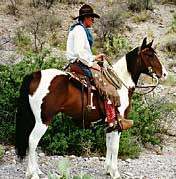Spanish-Barb
N/A
Sun, 20th April, 2025 - 12:43 pm GMT
Sponsor Ads:

Alternative Name
N/ABasic Info
The Spanish Barb stands 14 to 15 hands with the median height being 14.2 to 14.3 hands. This breed has remained within the natural "size to height" ratio which students of equine physiology consider to be optimum. The profile is straight to slightly convex as was that of its ancestors. The ears are short to moderate in length, most often being notched at the tip. The Spanish Barb has an expressive eye, a broad forehead and the head tapers to a small muzzle. The neck is well arched on the top line, broad at the base and blending into a shoulder of good to excellent length and angle. The back is short to medium in length and the loin it strong and powerful. The croup can be rounded or slightly angular with a medium to low tail set. The legs are medium in length with cannons of excellent circumference. The hooves are ample in size and are extremely tough. The mane and tail is full, particularly in the stallions. The Spanish Barb may reflect more Barb heritage with a narrower chest and slightly angular croup, or he may reflect more Iberian heritage with a broader chest and rounder croup. Whether tending more toward the Barb type or the Iberian type, the overall appearance of the Spanish Barb should be one of balance. the Spanish Barb is usually a solid-colored horse of black, sorrel, chestnut or any of a wide variety of shades of roan, grullo, dun or buckskin. No description of the Spanish Barb would be complete without mentioning his great strength of spirit. He not only possesses the physical attributes to accomplish any task but also his very essence brings a vitality to the pursuit of those tasks
Health
N/AHabitat
N/ABehavior
They are noted for their smooth gait, comfortable ride, and surefootedness, which makes them an excellent horse for trail and endurance riding and ranch work.Origin
SpainHistory
The Spanish Barb has a legacy bequeathed out of the Spanish discovery, exploration and colonization of the New World. Arriving by ship to confront foreign environs, the Spanish Barb horse adapted, endured and survived the epoch of exploration, conquest and colonization, and continued through the age of settlement of the American West. The Spanish Barb was one of America's greatest resources and without the presence of these horses, history would read quite differently. Once the New World was firmly established, the Spanish Barb forged ahead to other tasks. Whether war horse, mission horse or ranch horse, the Spanish Barb fulfilled his destiny with extraordinary success, facilitating the power of movement critical to founding a new nation. This nation was dependent on the Spanish Barb "work" horse, instead of the imported "sport" horse until the time of the Industrial Revolution when a mechanized society became the order of the day. The Spanish Barb horse has an ancient origin. He is the result of crossing the African Barb, or Berber horse with the resident horse of the Iberian Peninsula after the Moors invaded Spain in 711 AD. The precursors of the Barb/Iberian horse are attributed to having descended from Equus stenonius, one of the six original types of wild horses known to man. The Barb/Iberian horse was developed by those cultures who depended on their horses in every day life. It is these cultures which have always produced the world's best horses. The Spanish Barb was nearly cross-bred and abandoned to the point of extinction around the turn of the 20th century. Fortunately enough 20th century horseman realized that a treasure was about to be lost and dedicated themselves to preserving a nucleus of those horses. Time and circumstance had resulted in some degeneration of the original Spanish Barb, so it became necessary to institute strict breeding programs in an effort to restore this horse to his original state. This was accomplished by culling those individuals who did not consistently produce Spanish Barb phenotype. All horses are inspected before they are registered and each stands on it's own merit, regardless of his parentage. There are two divisions in the Registry: the lower division is for foals and for adult horses which score in the median to low range; and, the upper division is for horses who are inspected again after reaching three years of age and score in the upper percentile. It is from the upper division of the Registry that breeders are encouraged to select their breeding stock. The first quarter century of the Registry, there were five bloodlines being used: the Romero; the Belsky; the Coche Two; the A-ka-wi; and, the Sun. The Wilbur-Cruce Mission Strain, which is a rancher gene pool having over 113 years of history on one ranch, was added in 1996 (*). Each bloodline has documentation to support it, with three of the six being rancher gene pools, two of which date back to the 1800's. None of the foundation horses were feral. No horse was brought in from the range and placed in the Registry even though three of the lines do trace back to some feral stock. The goal of the Spanish Barb Breeders Association has been to produce the best Spanish Barb possible and to do so in the mold of the horse brought to this continent by the Conquistadores. The Spanish Barb Registry constitutes an "untampered" with breed of horse, which has been continually bred to be a composite of those characteristics of excellence with which the original Barb/Iberian horse was endowed.Common Foods
grassSponsor Ads:
A stumble may prevent a fall. --English Proverb
Spanish-Barb
Coded by: BGID® | ALL RIGHTS RESERVED Copyright © 2000-2025
Disclaimer | Privacy | Report Errors / Contact | Credits
















